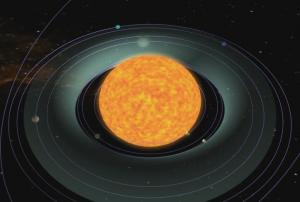Should we narrow the search for life-bearing planets to Sun-like stars? The answer may be ‘no’ if we take age into account, according to a new study from an international team of astronomers. Stars well into their red-giant phase may have actually revived outer, icy planets to offer them a chance at developing living ecosystems of their own. This happens because stars become brighter as they get older, pushing their habitable zones deeper into any planetary system they possess.
The study considered the aging process of stars having the same mass as the Sun, and also considered stars with 1.5 and 2 times its mass. “Our result indicates that searches for life-giving worlds outside our solar system should include planets around old stars,” said Dr. Bruno Lopez of the Observatoire de la Cote d’Azur, Nice, France. Lopez is lead author of a paper on this research that is to appear in The Astrophysical Journal.

Image: A sun-like star grows into its red giant phase, increasing in size and luminosity. Energy in the form of heat can now reach a once-frozen and dead moon. The icy surface quickly melts into liquid water, filling in old craters with warmer seas. The stage is now set for the possible formation of new life. Credit: NASA.
In order for life to form on worlds around red giants, a lengthy period of stability is required. The earliest fossils on Earth are some 3.5 billion years old, although life probably evolved earlier, its traces obscured by the planet’s changing geology. But assume one-half to one billion years for the emergence of life and the numbers look promising. Planets between 2 and 9 AU from a solar-mass star may have a window of up to two billion years for life to emerge as their sun’s habitable zone grows.
“The temporal transit of the habitable zone does not appear incompatible with the possible duration for the development of life,” said co-author Dr. Jean Schneider of the Observatoire de Paris, France. And Dr. William Danchi of NASA’s Goddard Space Flight Center, a co-author of the paper, speculated that microbes from inner worlds might make their way to outer planets in such a system, allowing life to take hold even when the red giant phase proved too swift for its normal development.
More on these speculations can be found at this GSFC page, which also contains interesting animations of changing habitable zones. The paper in question is Lopez, Schneider and Danchi, “Can Life develop in the expanded habitable zones around Red Giant Stars?” available in preprint form at the ArXiv site.


Using ESO’s VLTI on Cerro Paranal and the VLBA facility
operated by NRAO, an international team of astronomers
has made what is arguably the most detailed study of the
environment of a pulsating red giant star, leading to significant
progress in our understanding of the mechanism of how,
before dying, evolved stars lose mass and return it to the
interstellar medium.
Read more in ESO 25/07 at
http://www.eso.org/public/outreach/press-rel/pr-2007/pr-25-07.html
Newfound Planet Has Earth-Like Orbit
By Ker Than
Staff Writer
posted: 02 August 2007
03:09 pm ET
A planet outside our solar system with a year roughly equal to Earth’s has been discovered around a dying, red giant star.
Only about 10 red giant stars are known to harbor planets; the new solar system is among the most distant of these.
Our sun will become a red giant in a few billion years, likely vaporizing Earth.
The finding, to be detailed in the November issue of Astrophysical Journal, was made by a team led by Penn State astronomer Alex Wolszczan, who in 1992 discovered the first planets outside our solar system around a deadly, radiation-spewing star.
Full article here:
http://www.space.com/scienceastronomy/070802_redgiant_planet.html
Circumstellar water vapour in M-type AGB stars: Radiative transfer models, abundances and predictions for HIFI
Authors: Matthias Maercker, Fredrik L. Schoeier, Hans Olofsson, Per Bergman, Sofia Ramstedt
(Submitted on 7 Jan 2008)
Abstract: Aims: By performing a detailed radiative transfer analysis, we determine fractional abundances of circumstellar H2O in the envelopes around six M-type asymptotic giant branch stars. The models are also used to predict H2O spectral line emission for the upcoming Herschel/HIFI mission.
Methods: We use Infrared space observatory long wavelength spectrometer spectra to constrain the circumstellar fractional abundance distribution of ortho-H2O, using a non-local thermal equilibrium, and non-local, radiative transfer code based on the accelerated lambda iteration formalism. The mass-loss rates and kinetic temperature structures for the sample stars are determined through radiative transfer modelling of CO line emission based on the Monte-Carlo method. The density and temperature profiles of the circumstellar dust grains are determined through spectral energy distribution modelling using the publicly available code Dusty.
Results: The determined ortho-H2O abundances lie between 1e-4 and 1.5e-3 relative to H2, with the exception of WX Psc, which has a much lower estimated ortho-H2O abundance of only 2e-6, possibly indicating H_2O adsorption onto dust grains or recent mass-loss-rate modulations. The estimated abundances are uncertain by, at best, a factor of a few.
Conclusions: The high water abundance found for the majority of the sources suggests that either the `normal’ chemical processes are very effective in producing H2O, or else non-local thermal equilibrium atmospheric chemistry, grain surface reactions, or a release of H_2O (e.g. from icy bodies like Kuiper belt objects) play a role. We provide predictions for ortho-H2O lines in the spectral window of Herschel/HIFI.
Comments: Accepted by A&A, Dec 12 2007, 13 pages, 8 figures
Subjects: Astrophysics (astro-ph)
Cite as: arXiv:0801.0971v1 [astro-ph]
Submission history
From: Matthias Maercker [view email]
[v1] Mon, 7 Jan 2008 13:48:25 GMT (411kb)
http://arxiv.org/abs/0801.0971